问答
发起
提问
文章
攻防
活动
Toggle navigation
首页
(current)
问答
商城
实战攻防技术
漏洞分析与复现
NEW
活动
摸鱼办
搜索
登录
注册
VEH&SEH异常详解
因为Trap_Frame结构在3环的原因,会有一个从0环临时返回3环的过程,所以在用户层的异常执行过程相比于内核层更加复杂,我们继续探究。
0x00 前言 ======= 因为`Trap_Frame`结构在3环的原因,会有一个从0环临时返回3环的过程,所以在用户层的异常执行过程相比于内核层更加复杂。 0x01 VEH ======== 首先定位到`KiUserExceptionDispatcher`函数,这里首先通过`RtlDispatchException`来找到异常处理的函数 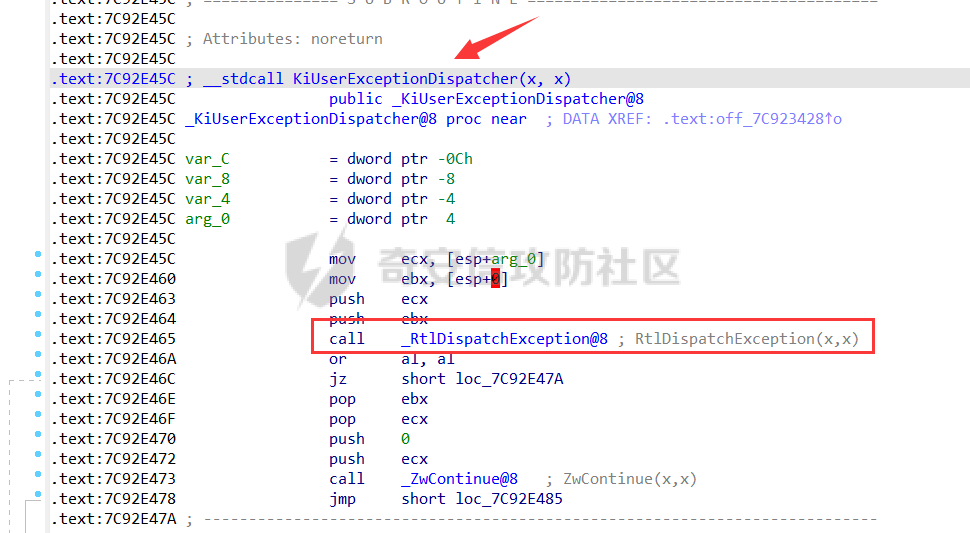 经过异常处理之后调用`ZwContinue`重新进入0环,这里是因为`Trap_Frame`结构被修改了,这里需要重新进入0环把新的值传入 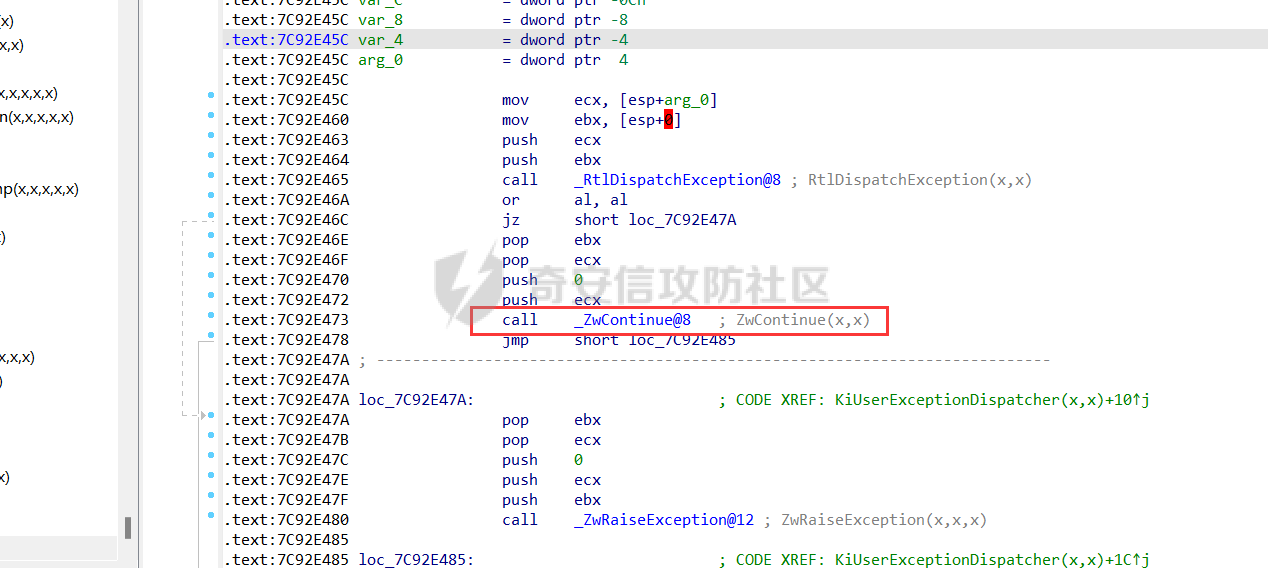 如果这里异常没有处理成功会再次分发异常 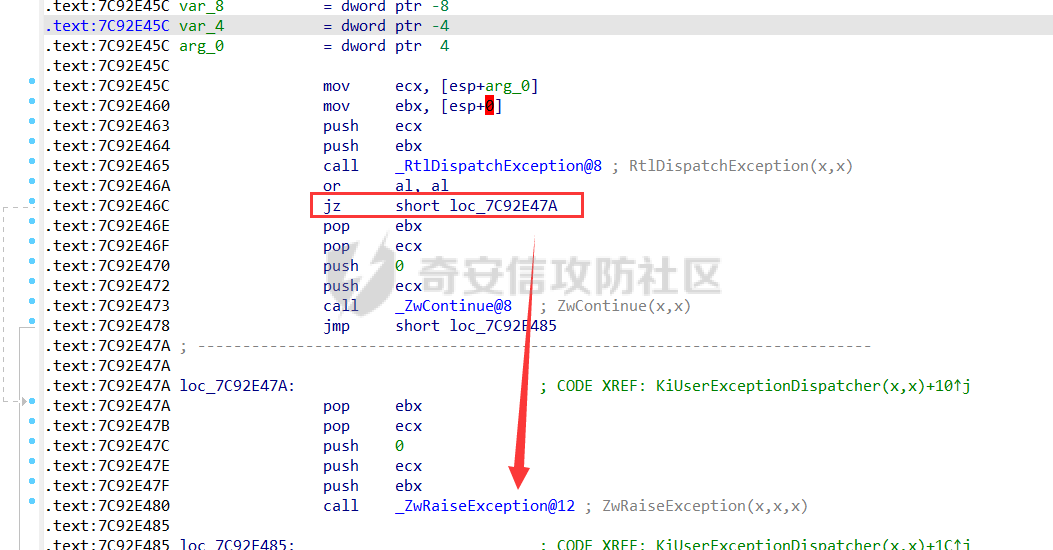 RtlDispatchException -------------------- 这里`RtlDispatchException`是分发异常的函数,0环跟3环是共用的,但是有一些细节是不同的,我们跟进去看看  首先看一下3环的`RtlDispatchException`里面有一个`RtlCallVectoredExceptionHandlers` 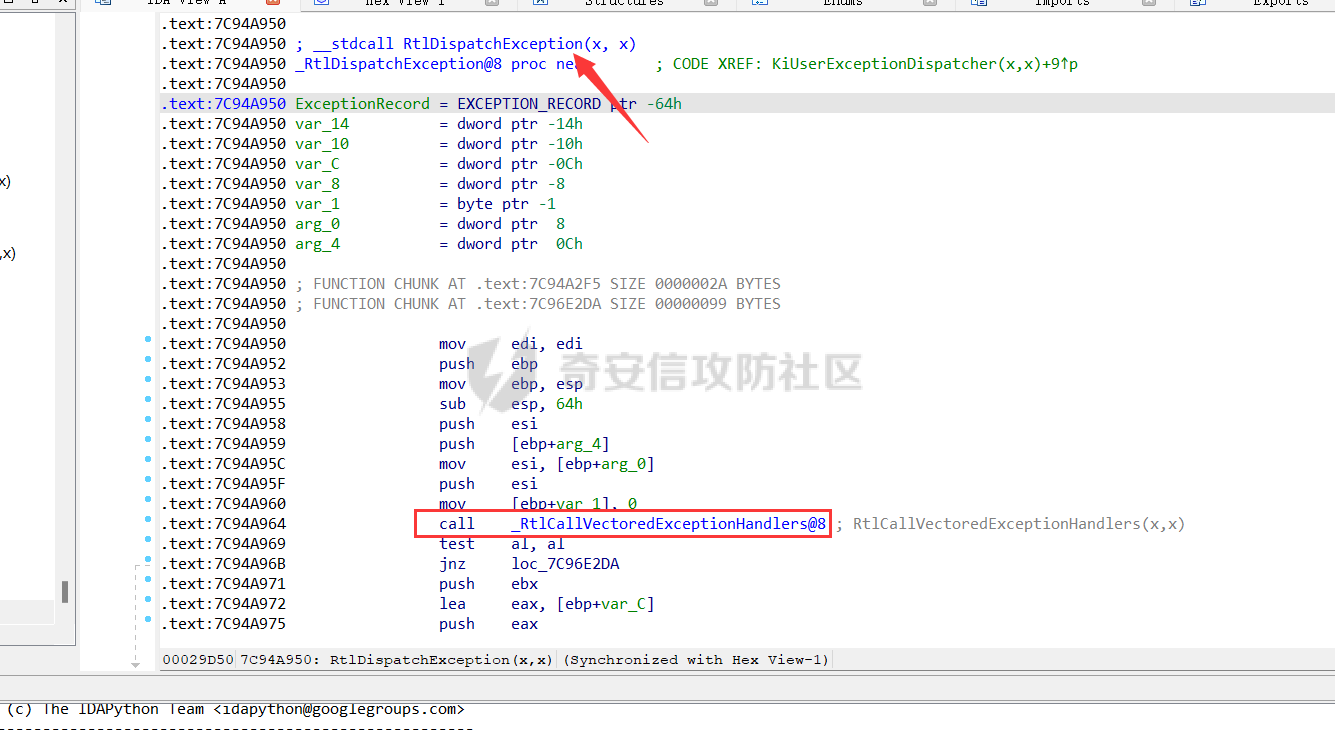 但是在0环的`RtlDispatchException`里面是没有这个函数的 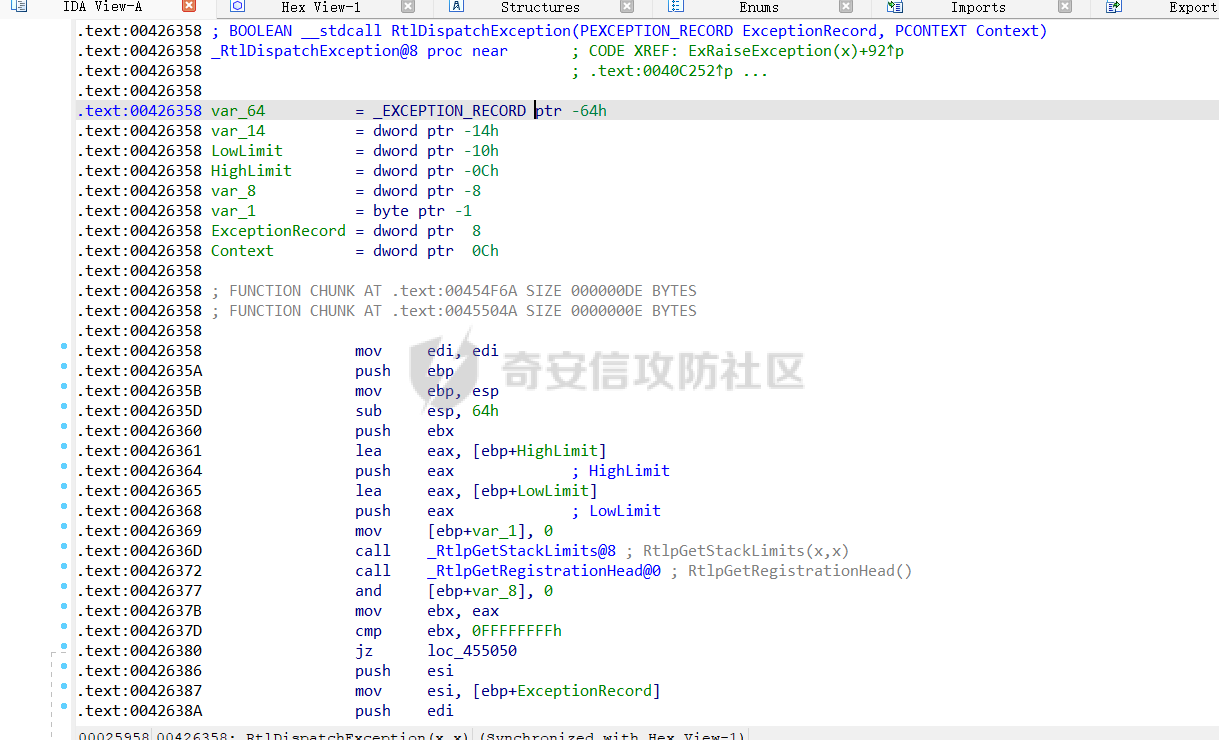 跟进`RtlCallVectoredExceptionHandlers`,首先找全局链表(VEH链表),存储了很多个异常处理函数,如果在全局链表里面没有找到,就会继续往下找局部链表(SEH链表) 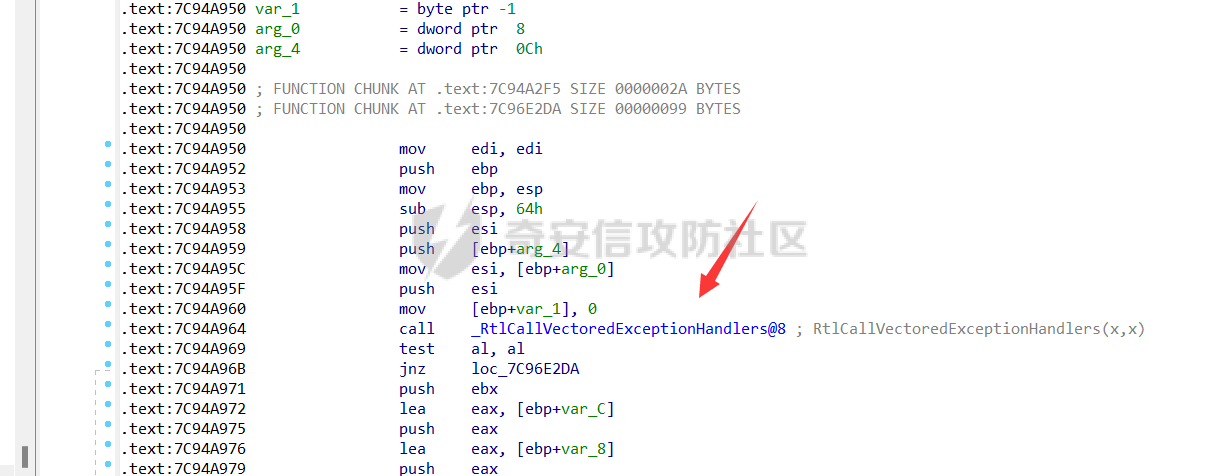 我们尝试用代码来实现VEH ```c++ // VEH1.cpp : Defines the entry point for the console application. // #include "stdafx.h" #include <windows.h> typedef PVOID (NTAPI *FnAddVectoredExceptionHandler)(ULONG, _EXCEPTION_POINTERS *); FnAddVectoredExceptionHandler MyAddVectoredExceptionHeader; // UEH异常处理函数只能返回2个值 // EXCEPTION_CONTINUE_EXECUTION 已处理 // EXCEPTION_CONTINUE_SEARCH 未处理 LONG NTAPI VectExceptionHandler( PEXCEPTION_POINTERS pExcepInfo ) { ::MessageBoxA(NULL, "VEH Function run", "VEH error", MB_OK); if (pExcepInfo->ExceptionRecord->ExceptionCode == 0xC0000094) { //pExcepInfo->ContextRecord->Eip = pExcepInfo->ContextRecord->Eip + 2; pExcepInfo->ContextRecord->Ecx = 1; return EXCEPTION_CONTINUE_EXECUTION; } return EXCEPTION_CONTINUE_SEARCH; } VOID VEH() { // 动态获取AddUectoredExceptionHandler函数地址 HMODULE hMyModule = GetModuleHandle("kernel32.dll"); MyAddVectoredExceptionHeader = (FnAddVectoredExceptionHandler)::GetProcAddress(hMyModule, "AddVectoredExceptionHandler"); // 参数1表示插入VEH链的头部、0表示插入到UEH链的尾部 MyAddVectoredExceptionHeader( 0, (_EXCEPTION_POINTERS *)&VectExceptionHandler ); // 构造除0异常 __asm { xor edx,edx xor ecx,ecx mov eax,0x10 idiv ecx // EDX:EAX 除以 ECX } printf("veh_code run here again"); } int main(int argc, char* argv[]) { VEH(); getchar(); return 0; } ``` AddVectoredExceptionHandler --------------------------- 这里有几个注意的点,首先是注册异常处理函数,使用到`AddVectoredExceptionHandler`,这个函数是在`kernel32.dll`里面的,在xp以前的版本里面是没有的,所以需要动态获取 ```c++ PVOID AddVectoredExceptionHandler( ULONG First, PVECTORED_EXCEPTION_HANDLER Handler ); ``` 第二个要注意的点就是veh是一个链表,第一个参数表示插入异常的位置,1的话就是插入到链表的头部,0的话就是插入到链表的尾部  第三个点就是异常处理的指针指向两个结构,一个是`ContextRecord`,这个结构里面存储的是所有寄存器的值,另外一个就是`ExceptionRecord`,这个结构里面存储的就是异常的具体信息  第四个点就是因为构造的是ecx为0,那么这里异常处理函数就可以修改eip指向的地址或者修改ecx的值为1即可 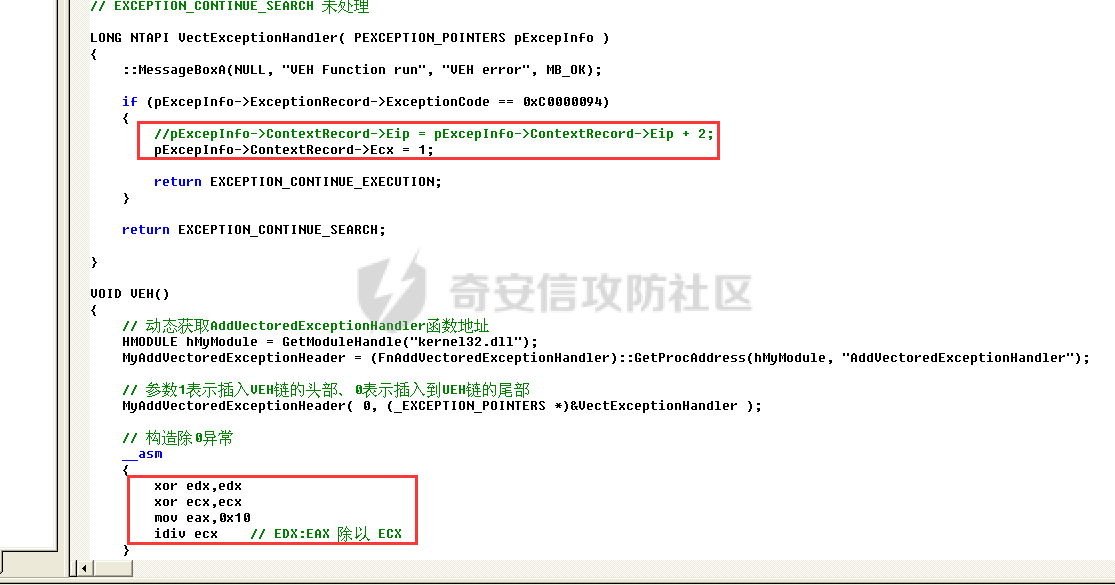 看下效果,首先是执行了我们自己注册的异常处理函数里面的`MessageBoxA`,然后程序正常下向下执行 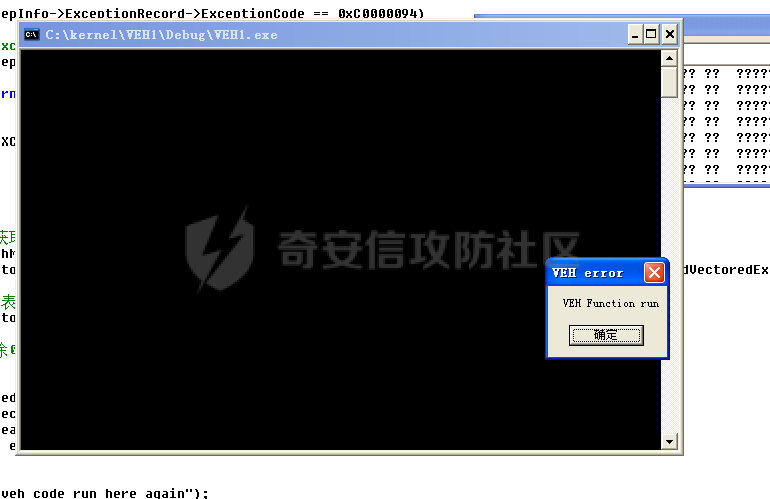 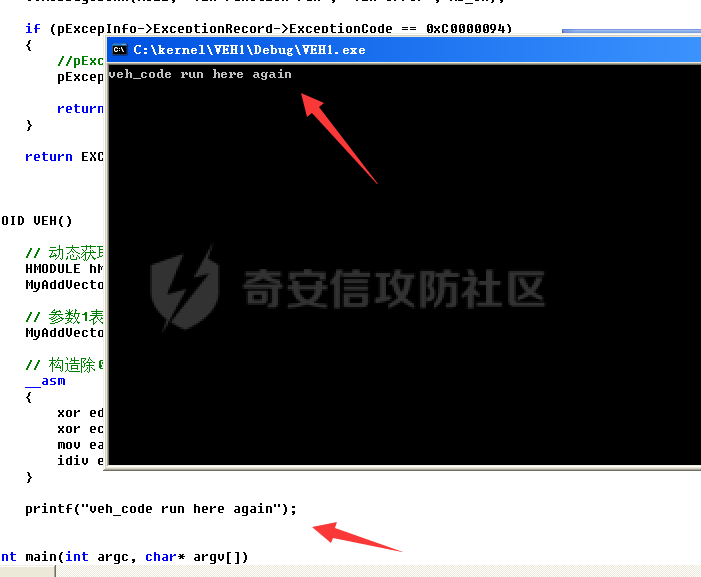 VEH异常流程 ------- 1.CPU捕获异常信息 2.通过`KiDispatchException`进行分发(`EIP=KiUserExceptionDispatcher`) 3.`KiUserExceptionDispatcher`调用`RtlDispatchException` 4.`RtlDispatchException`查找VEH处理函数链表 并调用相关处理函数 5.代码返回到`KiUserExceptionDispatcher` 6.调用`ZwContinue`再次进入0环(`ZwContinue`调用`NtContinue`,主要作用就是恢复`TRAP_FRAME` 然后通过`KiServiceExit`返回到3环)。 7.线程再次返回3环后,从修正后的位置开始执行 0x02 SEH ======== SEH就是一个跟0环异常处理结构类似的链表 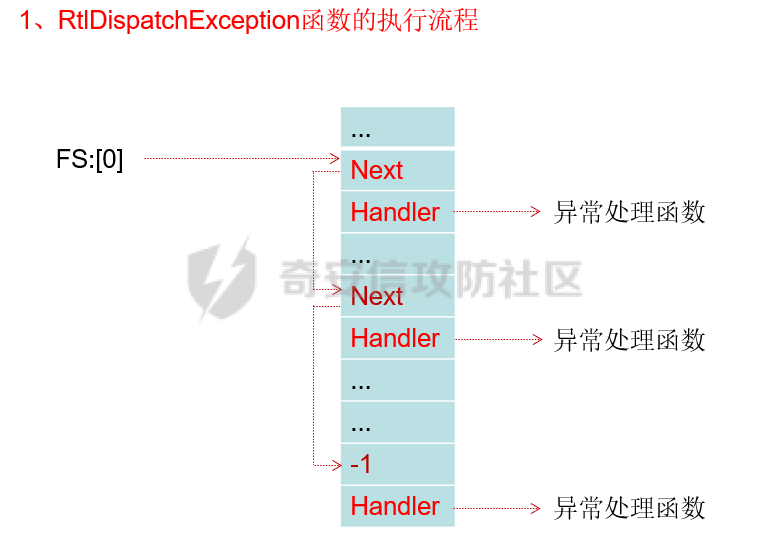 首先看一下`RtlpGetStackLimits` 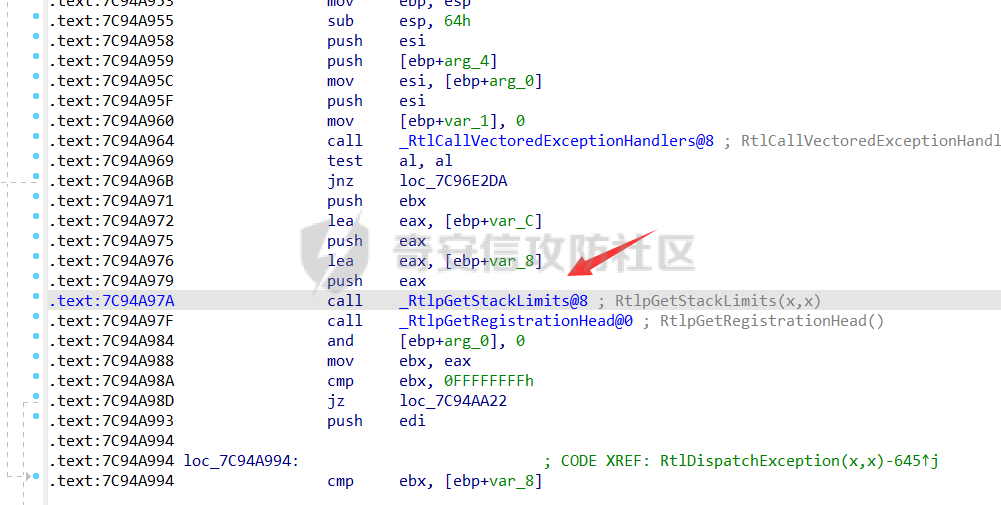 取出了`fs:[8]`和`fs:[4]` 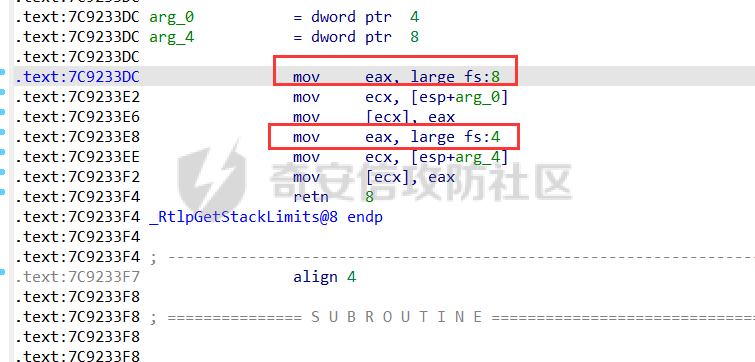 我们知道`fs:[0]`指向的是`_NT_TIB`结构,那么`fs:[4]`对应的就是`StackBase`,`fs:[8]`对应的就是`StackLimit`,即基址和界限 然后再拿到`fs:[0]`   拿到一系列的参数之后,会首先进行一系列的判断 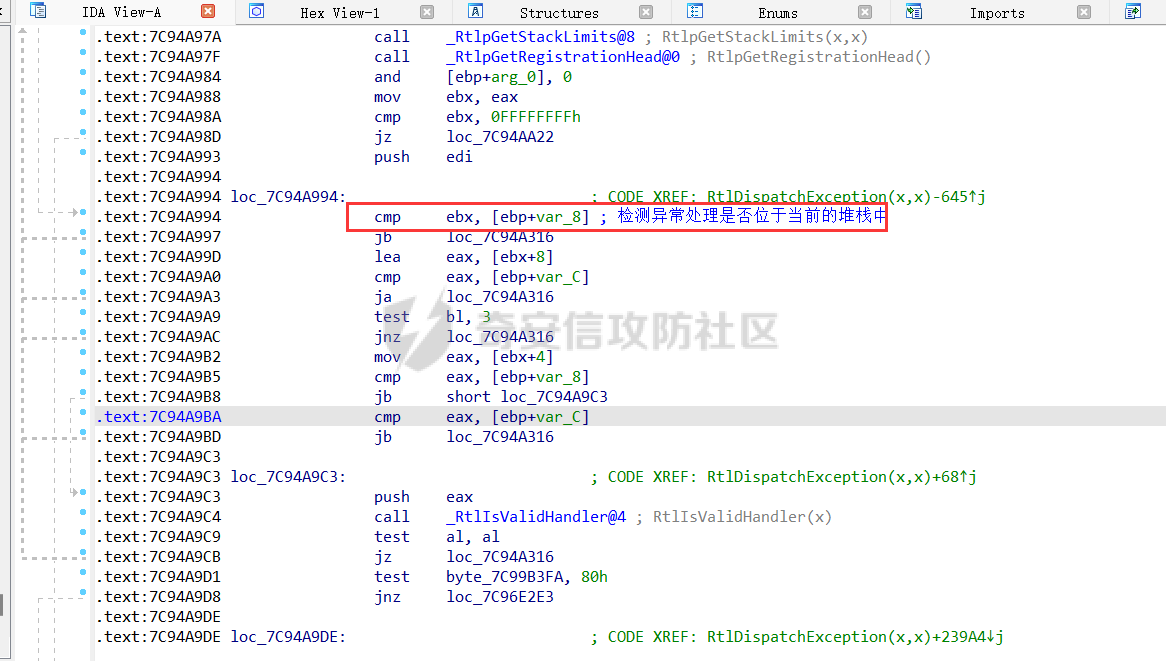 RtlpExecuteHandlerForException ------------------------------ 最后调用`RtlpExecuteHandlerForException`处理异常 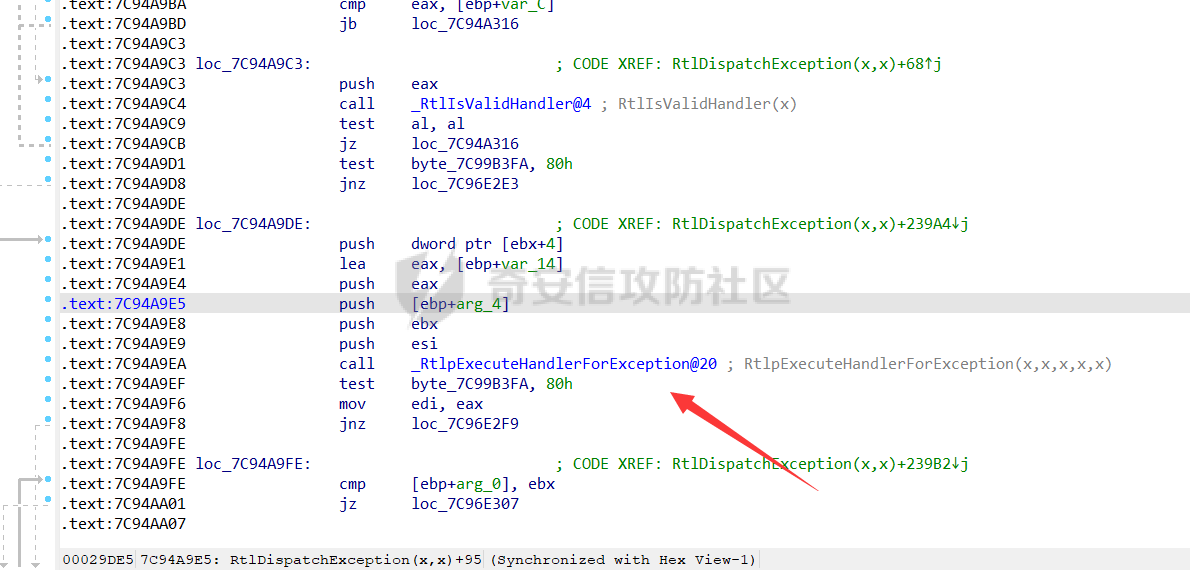 SEH异常的实现 ```c++ // SEH1.cpp : Defines the entry point for the console application. // #include "stdafx.h" #include <windows.h> // ring0 /* typedef struct _EXCEPTION_REGISTRATION_RECORD { struct _EXCEPTION_REGISTRATION_RECORD *Next; PEXCEPTION_ROUTINE Handler; } EXCEPTION_REGISTRATION_RECORD; */ struct MyException { struct MyException *prev; DWORD Handle; }; EXCEPTION_DISPOSITION __cdecl MyException_Handler( struct _EXCEPTION_RECORD *ExceptionRecord, // ExceptionRecord 存储异常信息 什么类型异常产生位置 void* EstablisherFrame, // MyException结构体地址 struct _CONTEXT *ContextRecord, // Context结构体 异常发生时的各种寄存器值堆栈位置等 void* DispatcherContext) { ::MessageBoxA(NULL, "SEH Function", "SEH error", MB_OK); if (ExceptionRecord->ExceptionCode == 0xC0000094) { ContextRecord->Eip = ContextRecord->Eip + 2; return ExceptionContinueExecution; } return ExceptionContinueSearch; } void ExceptionTest() { DWORD temp; MyException myException; __asm { mov eax,FS:[0] mov temp,eax lea ecx,myException mov FS:[0],ecx } myException.prev = (MyException*)temp; myException.Handle = (DWORD)&MyException_Handler; __asm { xor edx,edx xor ecx,ecx mov eax,0x10 idiv ecx } // 摘除链表 __asm { mov eax,temp mov FS:[0],eax } printf("SEH run again"); } int main(int argc, char* argv[]) { ExceptionTest(); getchar(); return 0; } ``` \_EXCEPTION\_REGISTRATION ------------------------- 首先定义一个异常处理`_EXCEPTION_REGISTRATION`结构  然后定义异常处理函数 ```c++ EXCEPTION_DISPOSITION __cdecl MyException_Handler( struct _EXCEPTION_RECORD *ExceptionRecord, // ExceptionRecord 存储异常信息 什么类型异常产生位置 void* EstablisherFrame, // MyException结构体地址 struct _CONTEXT *ContextRecord, // Context结构体 异常发生时的各种寄存器值堆栈位置等 void* DispatcherContext) ```  然后在当前线程里面声明结构体,把自己的结构体挂到链表里面,并定义`Next`指针指向下一个结构体 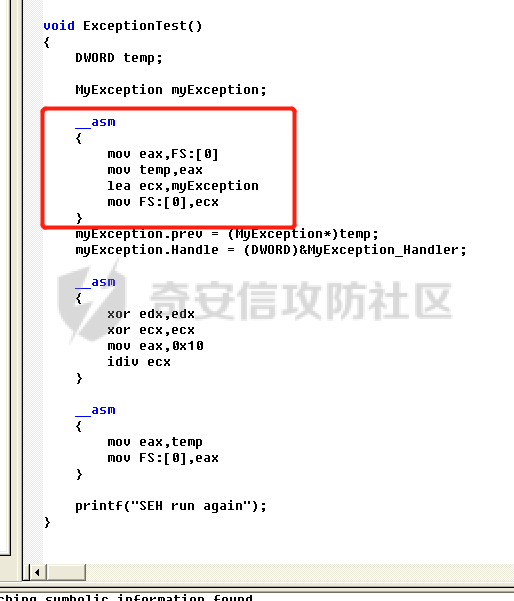 然后构造除0异常,然后将我们自己定义的结构体从链表里面摘除 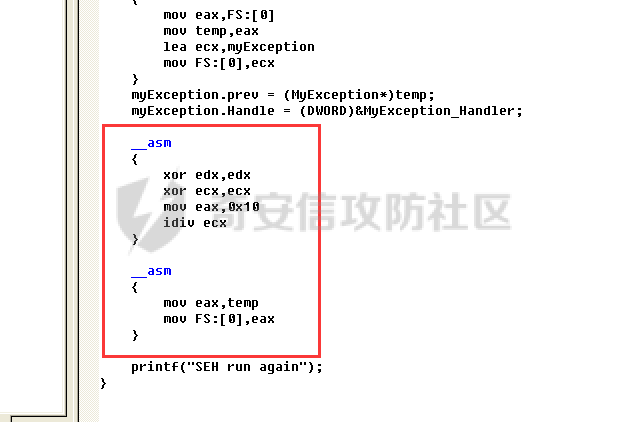 运行结果如下 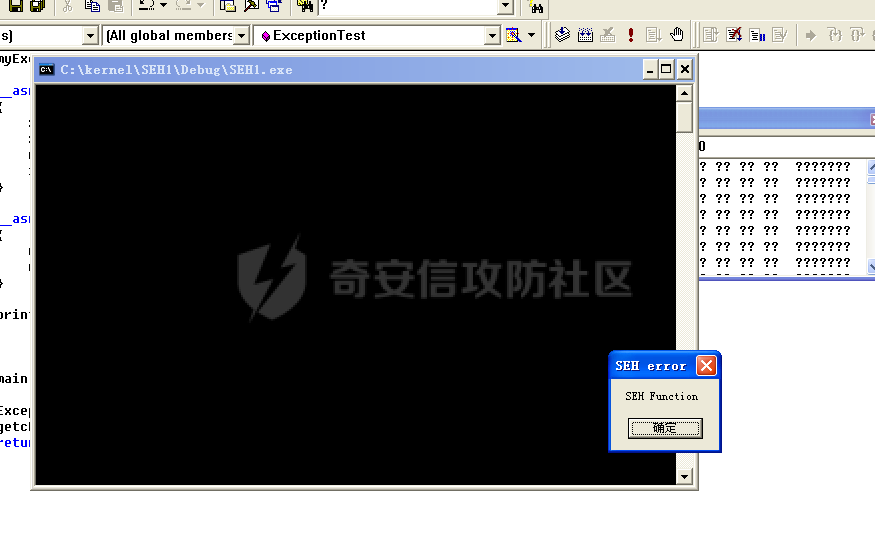 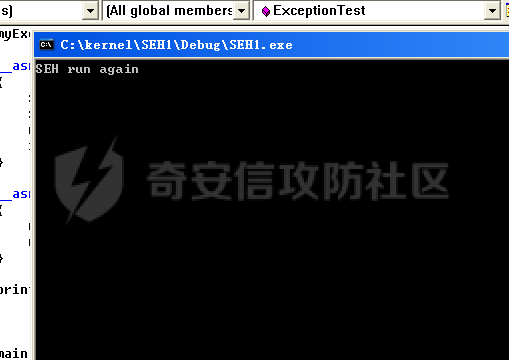 **总结** 1.FS:\[0\]指向SEH链表的第一个成员 2.SEH的异常处理函数必须在当前线程的堆栈中 3.只有当VEH中的异常处理函数不存在或者不处理才会到SEH链表中查找 SEH异常流程 ------- 1.`RtlpGetStackLimits`取出`_NT_TIB`结构的`fs:[4]`和`fs:[8]`,那么`fs:[4]`对应的就是`StackBase`,`fs:[8]`对应的就是`StackLimit`,即基址和界限 2.`RtlpGetRegistrationHead`取出`_NT_TIB`结构的`fs:[0]`,取出`ExceptionList` 3.然后调用`RtlpExecuteHandlerForException`处理异常 0x03 SEH编译器扩展 ============= 编译器可以直接帮我们进行简化挂入链表、异常过滤、执行异常处理程序的操作 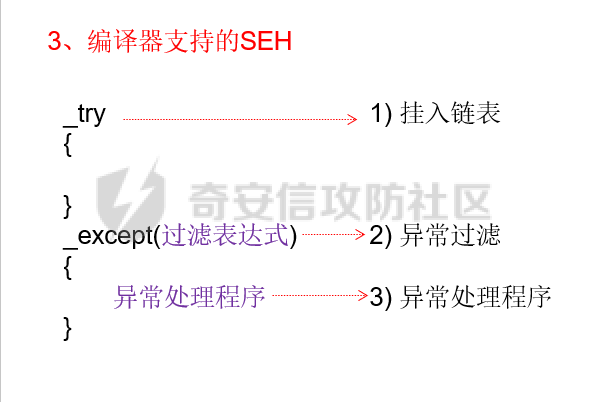 在过滤表达式处只能有以下三种情况 ```c++ 1) EXCEPTION_EXECUTE_HANDLER(1) 执行except代码 2) EXCEPTION_CONTINUE_SEARCH(0) 寻找下一个异常处理函数 3) EXCEPTION_CONTINUE_EXECUTION(-1) 返回出错位置重新执行 ``` 而过滤表达式可以有3种写法 ```c++ 1) 直接写常量值 2) 表达式 3) 调用函数 ``` 常量值 --- ```c++ // SEH2.cpp : Defines the entry point for the console application. // #include "stdafx.h" #include <windows.h> void ExceptionTest() { _try { _asm { xor edx,edx xor ecx,ecx mov eax,0x10 idiv ecx } } _except(EXCEPTION_EXECUTE_HANDLER) { printf("SEH function run"); } } int main(int argc, char* argv[]) { ExceptionTest(); getchar(); return 0; } ``` 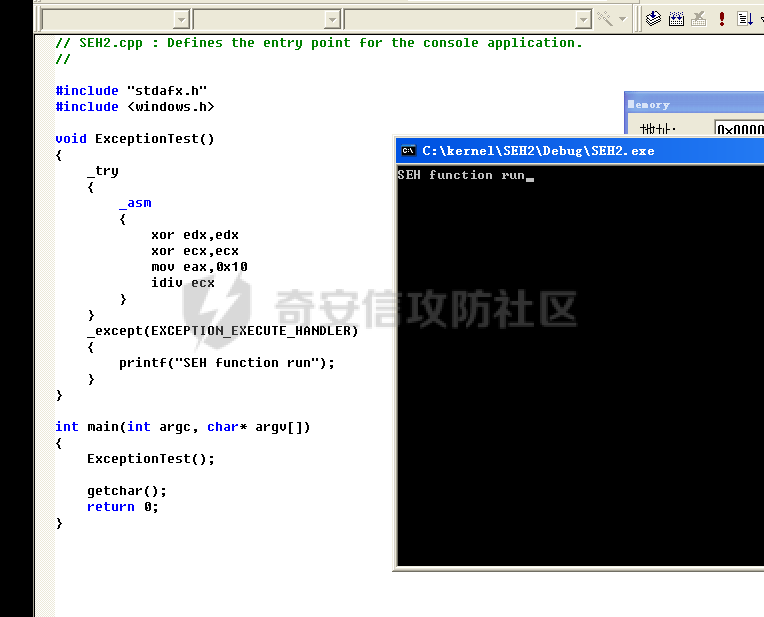 表达式 --- 使用`GetExceptionCode`得到异常码 ```c++ // SEH3.cpp : Defines the entry point for the console application. // #include "stdafx.h" #include <windows.h> void ExceptionTest() { _try { _asm { xor edx,edx xor ecx,ecx mov eax,0x10 idiv ecx } } _except(GetExceptionCode() == 0xC0000094?EXCEPTION_EXECUTE_HANDLER:EXCEPTION_CONTINUE_SEARCH) { printf("SEH function run"); } } int main(int argc, char* argv[]) { ExceptionTest(); getchar(); return 0; } ``` 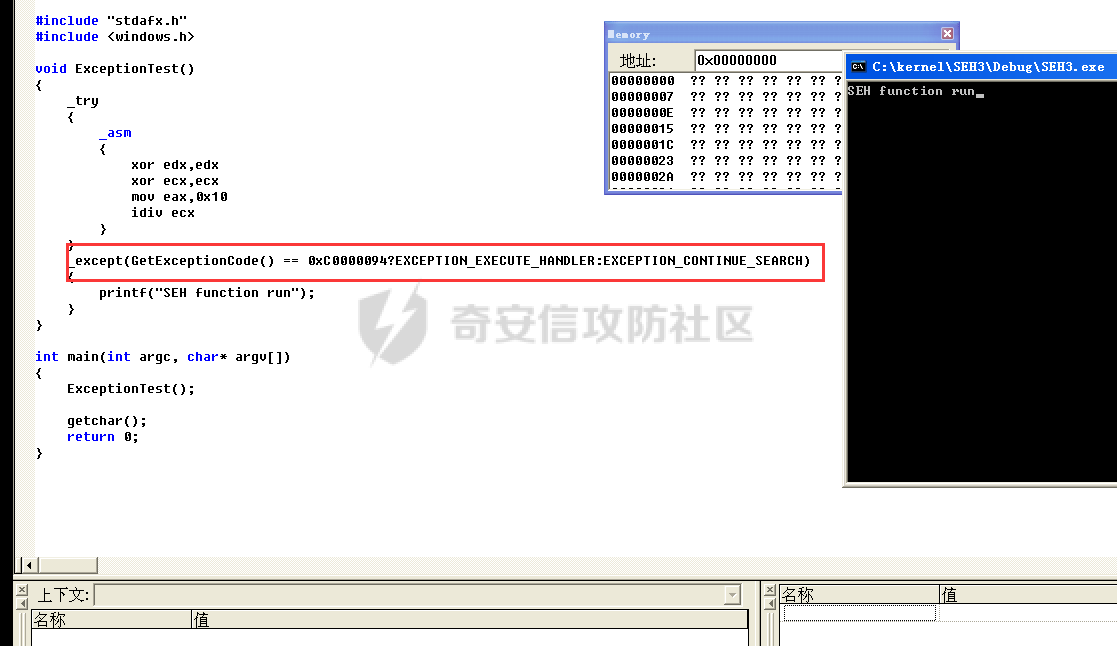 调用函数 ---- 使用`GetExceptionInformation`得到指向异常处理结构的指针 ```c++ // SEH4.cpp : Defines the entry point for the console application. // #include "stdafx.h" #include <windows.h> int ExceptFilter(LPEXCEPTION_POINTERS pExceptionInfo) { pExceptionInfo->ContextRecord->Ecx = 1; return EXCEPTION_CONTINUE_EXECUTION; // -1 返回出错位置重新执行 } void ExceptionTest() { _try { _asm { xor edx,edx xor ecx,ecx mov eax,0x10 idiv ecx } } _except(ExceptFilter(GetExceptionInformation())) { printf("SEH function run"); } } int main(int argc, char* argv[]) { ExceptionTest(); getchar(); return 0; } ``` 这里先修改值之后回到异常发生的地方重新执行,没有异常了,然后就走到`getchar()`的地方 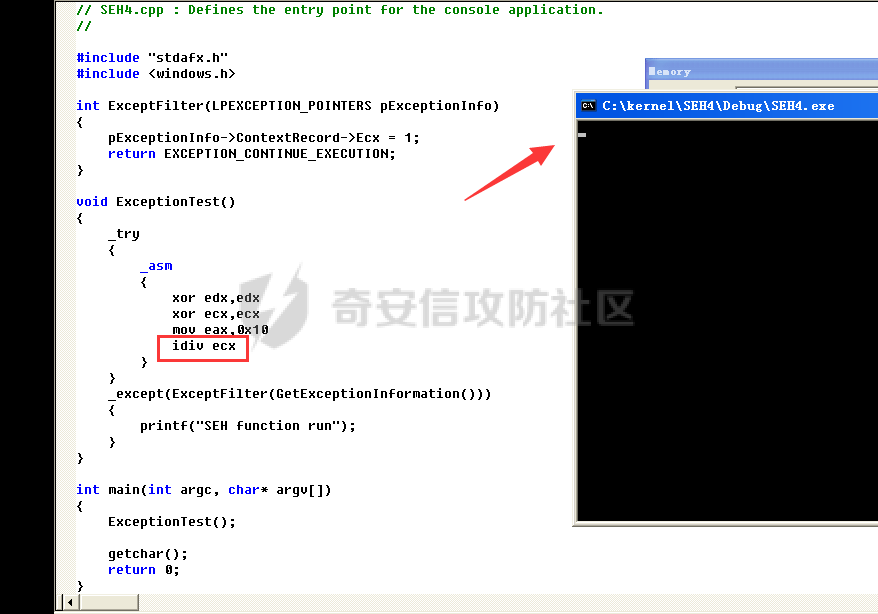
发表于 2022-04-25 09:44:17
阅读 ( 8859 )
分类:
漏洞分析
0 推荐
收藏
0 条评论
请先
登录
后评论
szbuffer
30 篇文章
×
发送私信
请先
登录
后发送私信
×
举报此文章
垃圾广告信息:
广告、推广、测试等内容
违规内容:
色情、暴力、血腥、敏感信息等内容
不友善内容:
人身攻击、挑衅辱骂、恶意行为
其他原因:
请补充说明
举报原因:
×
如果觉得我的文章对您有用,请随意打赏。你的支持将鼓励我继续创作!